Exactly one year ago today, the Portland Police Bureau Traffic Division carried out a stop sign enforcement action (a.k.a sting) at SE 23rd and Salmon.
Many cyclists received tickets and the incident touched off a heated debate (that rages on today). This debate includes issues like; the use of police resources, the conduct of law-breaking cyclists, questions about the effectiveness (and necessity) of stop signs, and so on.
I highly recommend a quick look back at my initial post and the comments from one year ago, as well as the follow-up statement by Lieutenant Mark Kruger. Those stories and perspectives offer an important education on the issues raised by the policies, behavior and practices of PDOT, the Police Bureau, and cyclists.
Since these enforcement actions (and resulting disagreements over them) are still being carried out, and because I was curious if anyhing has changed in the last year, I went back to that intersection this morning and did a little informal survey.
Here’s what I found out…
Conditions: Sunny, cool morning
The Numbers
Bikes (53 total)
Full stop – 9
Partial stop – 36
No stop – 8 (including one young kid)
Cars (16 total)
Full stop – 14
Partial – 2
No stop – 0
The Analysis
Several things surprised me during my short (and highly unscientific) observation.
First, I was amazed at how many more bicycles use this street than cars. It makes me wonder at what point does (or should) PDOT policy (engineering and enforcement) change to reflect the reality that streets like this one see more bikes than cars? It gives new meaning to the term bicycle boulevard.
Secondly, a very small percentage of cyclists follow the letter of the law at this intersection. Out of 53 total bikers, only nine came to a complete stop, and three of those were due to the presence of a motor vehicle.
I also spoke to a few folks.
The first guy I talked to actually got a ticket at this spot last year. He rides the route everday and says he would have come to “almost a complete stop” if I hadn’t waved him over prior to the sign.
I asked what he thought about the stop sign,
“I think that just generally, that since bikes cause almost no potential risk to other people, that vehicle laws should be changed to take into consideration the fact that bikes don’t have the same risk to other people that cars do… I slow down, I look both ways, but if I’m wrong, I’m the one who’s gonna’ get hurt, not the person in the car.”
Should they take out the sign?
“I defer to the people that live right around here. If there’s lots of little kids in this area…than they probably have a good reason to have a stop sign.”
That was an interesting response, because the cops initially started this enforcement based on a complaint from a nearby resident.
Another guy I talked to had a confession to make,
“I used to blow through the sign all the time, but when the cops started giving tickets out I stopped doing that because I didn’t want to get a ticket.”
I noticed one cyclist crossing the intersection (heading north). She said she’s nearly been hit by cyclists in this intersection.
According to BTA Director Evan Manvel, this stop sign was put in when PDOT made this an official bikeway back in the ’80s. He said the person who lived on one of the corners spoke up and made it happen.
As I rolled back toward town (riding downhill, westbound on Salmon) I couldn’t help but notice that similar intersections at SE 13th, 14th, and 17th do not have stop signs and seem to work just fine.
Given my observations, while it’s clear some cyclists remember last year’s enforcement action, it seems like it was more of a band-aid solution to a larger problem. That problem is two-fold; engineering and education.
We need to have PDOT take a closer look at this (and Ladd Circle) and engage the community to decide what works best for all the stakeholders (PDOT, Police, cyclists, neighbors). It would also help the entire equation if more cyclists tried just a little bit harder to follow the rules of the road.


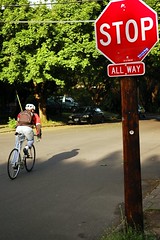
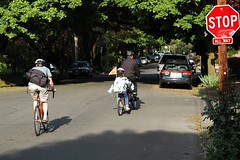
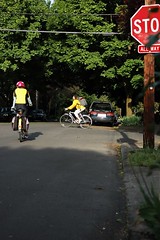
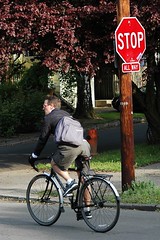
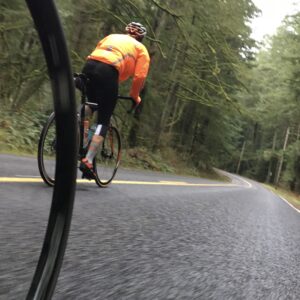
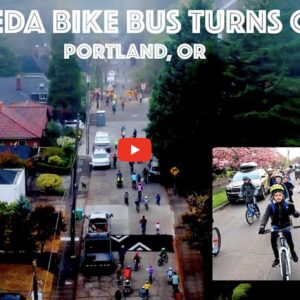
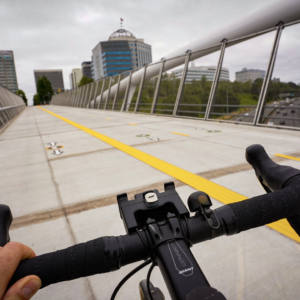
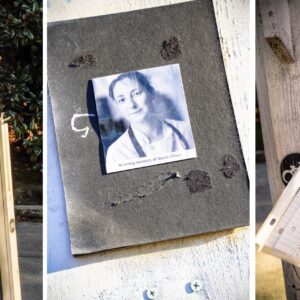
Thanks for reading.
BikePortland has served this community with independent community journalism since 2005. We rely on subscriptions from readers like you to survive. Your financial support is vital in keeping this valuable resource alive and well.
Please subscribe today to strengthen and expand our work.
Jonathan, I’m really glad you did this. I wish I’d had time to do it. I think the categorization of full, partial, and no stop is best for understanding behavior at the intersection, but of course there is no “partial stop” (essentially a yield?) in the eyes of the current law. So 83% of the cyclists you observed were breaking the law.
My view is that this demonststrates the utter lack of effectiveness of these stings. I think this is true despite the fact that we do not know the compliance rate before the sting because it can’t have been much lower than 17% (and certainly not statistically significantly lower).
And remember, in addition to being ineffective in changing cyclist behavior, the stings and the associated $242 fines are also likely discouraging people from cycling.
That adds up to bad policy. And no, I’m not saying it’s OK to break the law. I’m saying it’s not OK to break the law and that if we want to change this law-breaking behavior by cyclists we should try something that *actually works,* rather than something that just pisses people off for what is really a minor infraction.
And this is exactly what I expected we would find.
I am a mostly a stop sign scofflaw when on my bike and riding on light traffic streets like Salmon. I always stop at lights downtown, and do creative U-turn things at other reds when conditions permit.
There is a time when this kind of cycling will not work as this bike transport grows more common.
Years ago I rode from time to time in Davis, California. (Over 30 years ago, actually.) Davis was then THE bike mecca and had more bike traffic density than we do here now. It was very difficult and quite dangerous to negotiate busy intersections, even where most of the traffic was bikes, and most did not obey the control devices in place. It was to my recollection harrowing as bikes came and went every which way with little regard to order or safety.
We don’t want to go there.
My the question is at what point to do we end the present anarchy and become “good” bike citizens?
Michael,
I would suggest that there’s a HUGE continuum between full stops on bikes and “anarchy.” It’s not an either/or proposition.
I regularly roll stop signs (3-5 mph), but never blow them. I also never steal someone else’s turn. If it’s the guy to the right’s turn, I let him go. Basic courtesy.
I think that you can roll stop signs and still be a polite “good” citizen.
Jonathan,
Did any of the cyclists fail to yield to other traffic (cyclists, motorists, pedestrians…)?
What do they do in bike intensive Holland? There they have more dedicated bikeways.
The trick is how to codify common sense. How do you write one law that applies in down town as well as 27th and Clinton.
Here is an idea. At intersections with stop signs, every one defers to pedestrians. Bikes treat the intersection as a yellow/caution and must yield to cars with right of way. Cars must yield in the same manner as they are accustomed.
Small yield signs with a bicycle symbol could be mounted below the stop signs indicating where cyclists have the right to the yellow/caution status.
This way, main bike boulevards could be equipped with the subsidiary signs to maintain flow and momentum. Un-safe cyclist could still be cited under current law for recklessness. All other stop signs would really mean stop.
my 2 cents
I live just down the street from this intersection. If you’re heading west, the stop sign comes at a highly inopportune moment, in the middle of a steep, downhill stretch. Since the intersection is a four way stop, the west/east bound stop signs could easily be removed.
I strongly agree with the bike yield sign idea.
4 way stops are lazy traffic engineering. This is a corner in which we have about 1 car every 2 minutes at what is probably one of the busiest times of day for the intersection. At a minimum 2 of these stop signs should be removed (the two that are along the direction of travel that is the bike boulevard). It is likely though that with such a low flow of traffic the intersection would actually be safer with just a roundabout or similar calming measures and no stop signs.
bjorn
My vote’s for a roundabout & no stop signs facing east/west. Roundabouts provide the most visibility and priority to pedestrians.
PS to JMaus: two typos in the second quote.
I didn’t read all 70 some-odd comments back on the initial post but I read the first few and then skimmed and got the general feeling that the bike community (or at least the posters which is most of this blog, right?) wasn’t so up-in-arms about this sting, especially in contrast to the more recent examples of Ladd’s and the bike lane into the Springwater corridor. The posts here seem more about the possibly less than clever engineering of the site in question, whereas the more recent stings seem more about cop overkill and the logic of them worrying about bicyclists tackling cement trucks. or posting a posse of 7 police at a time in Ladd’s to make sure they get everybody. Sure the increased traffic warranted that but when we get into these larger numbers of police then it starts reminding some of us of the larger numbers we see at more serious events like marches and protests and all the other things that we see police getting noticed for in this town. Really I think they would be better served by not becoming so much of a force, but instead just a gentle reminder. Jonathan, I am really looking forward to your mayoral ride, and I hope it’s intimate instead of a parade, so he can see what a regular ride feel like instead of a crazy traffic-stopping parade that sometimes represents Portland bicyclists.
Paul
I use this route often and stop at the stop sign. What this intersection highlights is the need for a east-west bike only boulevard. A bike street with few stop signs. I’ve seen rails turned to trails. So let’s plan to turn Salmon into a bike only street.
Interesting timing on this, for me.
I passed through Ladd today for the first time since before the sting, and I lost my sympathy for the people who got ticketed then. I stopped at a stop sign at the circle for a pedestrian about to cross at the crosswalk, and even though she was talking on a cellphone she stopped to thank me for stopping; she said people almost never do.
I continued around the circle, and was getting ready to exit onto Harrison, when another cyclist blew the Ladd Avenue stop and passed me along my right side even though I was clearly signaling. Annoyed, I reminded him he had a stop sign. He shot back, “Yeah, I’m sure you stop at them too.” Yes, actually…
Roll through all the stops you want at your own risk if there’s no traffic coming, but have a little respect when there are people right there in front of you. Stopping for pedestrians and flashing a smile can make their day – so let’s try to be good ambassadors.
spencer asked what they do in bike-intensive Holland. I was in Holland 9 years ago and saw a handful of stop signs. I was there again 18 months ago and toured through 10 different towns, including Amsterdam, and didn’t see a single stop sign. Intersections, if not controlled by a signal, are then yield-controlled. Everywhere. For everyone. It works well there.
However, the big difference between here and there is that there people seemed to follow one basic traffic rule: if you have the right-of-way, take it. The corollary is that if you don’t have the right-of-way, yield. The problem here is that too many don’t follow this basic rule, as recounted by Elliot. That’s certainly my observation, as well. Most cyclists behave responsibly and well. But the outliers are noticeable and scary enough to ruin it for everybody else.
Could yield signs work here? Perhaps, if cyclists and motorists universally followed the spirit of yielding rather than behaving as if “yield” was simply a watered-down version of “stop.” “Yield” still means “stop” when there is approaching traffic from the right or a pedestrian. Could motorists and cyclists behave in that manner? Do enough of us do it now?
I believe that’s the main concern of the Police, neighbors, and PDOT engineers: that converting stops to yields would result in even less regard and respect for crossing traffic (including pedestrians) by motorists and cyclists.
I think that if we want cars to accept us as equal traffic participants, we have to abide the traffic rules… it’s the glass house thing!
So I am going to try to get my foot on the floor instead of just slowing down and screening/listening for coming cars!
Now to add to this conversation and the one on the new lane at SE 4th, a Portland officer is taking a new approach to driver education instead of writing tickets in SW. It is covered in today’s Oregonian:
http://www.oregonlive.com/news/oregonian/index.ssf?/base/news/1178938511134520.xml&coll=7&thispage=1
This type of policing should be applauded and passed onto those who police cyclists. It would be more effective and maybe help us move towards the yield model more.
I’ve never been ticketed on my bike. Then again, I don’t break the law. Sure, I don’t always agree with how the police spend their time, money and resources — but that doesn’t qualify me to decide which laws I think should be followed and which laws I feel I’m free to break.
Please feel free to continue the mindless mantra “Obey the law!” But that’s not what this discussion is about. It’s about how we develop and employ effective techniques for enhancing compliance. So if you have any actual ideas about how to do do that, that will be a more constructive contribution to the discussion.
I know what you mean about taking the right of way when you have it. How many times have you witnessed a “Go ahead,” “No, you first,” “No, really, you go first” situation, which always ends in someone feeling taken advantage of? I had one the other day, going East on SE Clinton through 26th, when my girlfriend and I stopped for a car on the left, and when the driver failed to act, we went ahead. The driver rolled down her window and scolded us for not following the traffic laws, and I told her I was not about to wait all day for her.
So if you have any actual ideas about how to do do that, that will be a more constructive contribution to the discussion.
If it was up to me, I would just remove the traffic signs. There are countless unmarked intersections in Seattle, with sometimes a planter/roundabout in the middle. People figure it out. My neighborhood has barely any traffic signs and I’ve only seen one accident, and this with plenty of people not slowing down much at all. Of course, I don’t know how busy this particular intersection is, but generally making people feel unsafe is a great way to make sure they watch their ass.
And Elliot, word about yielding to pedestrians. Everyone should try it a few times (they like it).
The problem with completely removing traffic signs is inevitably you will have two vehicles from different directions going fairly fast and somebody ends up getting T-boned. I have been witness to this and it’s ugly. As someone else commented, the American driving mentality is different than the European (or the Central American, or many other places).
Actually there are hundreds of intersections in NE portland that do not have any stop signs and don’t seem to have constant high speed accidents. Lowering the speed limit, or putting in traffic calming devices are both fine by me but I can’t believe that drivers in SE portland are so much less attentive than in NE that all those stop signs are needed. Not to mention that as Jonathan pointed out there are other intersections only blocks from that one that have no stop signs, and have no problems.
Bjorn
Interesting story. I used to ride SE Salmon from SE 38 and every stop signed I countered made sense to me from Sunnyside school to the major cross streets of 30th, 20th and 11th, but I could never understand why there was at SE 23, since most days I never saw anybody using it.
Your story makes me reach the conclusion, that the only reason that sign is there is for political reasons, as opposed to any valid traffic ones. PDOT was transforming the street to a bike blvd and the sign goes up to appease a resident who fears his/her local street is going to be over run by speeding cyclists. I guess in the big picture it was worth it because SE Salmon is a great road for going east/west on a bike.
Contrast with today when you ask PDOT to install a stop sign on a residential street to calm auto traffic and the first thing they’ll tell you is that stop signs actually make traffic speed up because drivers are compensating for the lost time from having to stop.
I don’t believe that “constant high speed accidents” is they real problem here. I do believe that reducing accidents period is what we’re after and some kind of traffic control is (IMO) what’s needed. Whether it’s in the form of stop signs, speed control humps, better education or a combination of things.
Most new Portlanders I’ve met are concerned about the lack of any traffic control at many 4-way intersections here in the city. Speed limit signs on their own certainly aren’t going to do it. For example, my wife was t-boned last year by a kid who was more than doubling the posted speed and didn’t see fit to slow down at the intersection. As a result, her car spun 180 and flipped onto the roof. Luckily, she only had minor injuries. Her view to her right was partially blocked by a van parked on the corner so she treated it like a stop sign, then went slowly through the intersection (which she always does anyway). T-bone.
I don’t personally care if traffic control devices are inconvenient to maintaining my speed. IMO, getting around by bike is about planning anyway…you have to plan how to carry your goodies, plan how you’re going to clean up at work, plan for kids, day care, dinner, etc…why can’t you plan for all the stops you know you’re going to have to make?
For the record, I roll through stops on occasion. Only after I’ve thoroughly check for peds, other cyclists, cars and cops. I don’t want to get a ticket, but the law is the law, and if I’m willingly disobeying it, I know that’s one of the consequences.
It seems to me that the best immediate solution to this intersection, and any similar intersection on a bicycle route, is to install a traffic circle, install zebra-stripe crosswalks, and remove the stop signs for the bicycle route (perhaps even the other stop signs as well).
And the best long-term solution would seem to be to go Idaho-style: Stop signs for bicycles = yield signs, stop lights for bicycles = stops signs.
And yes, the Portland Police need to make enforcement of traffic laws against bicycles their lowest priority. In fact, maybe we need to make funding the Portland Police our lowest priority as a community. Bust bicylists, hurt protesters, kill innocent civilians… do they actually contribute *anything* positive to the community anymore?
Bjorn,
I didn’t say constant, I said they happen, and a couple of immediate examples that come to mind were in NE Portland, and in one location, the city put stop signs in because the accident rate warranted it. Any sign removal or addition is going to be taking a look at the accident rate first.
“What do they do in bike intensive Holland? There they have more dedicated bikeways.”
I concur with Roger’s comments…there are less and less intersections marked with stop signs over the last 12 years in the NL. (In 3 weeks this fall I saw one stop sign in my 8 country bikeway/ ped tour of bike fiendly Europe.) Other than signals or ‘yield to your right’ there are shark’s teeth or crosswalks allocating right of way. Low speed controlled ciaos works very well too as a tool.
Yes we do have too many stop signs here…but then again our legislature/ local agencies have to be willing to lower speeds below 25 mph (to the point of pedestrian / bicyclist 99% survivability if a collision occurs – aka human error) and tighten up education/ enforcement of road user behavior.
Denver style stop control plans (every other block) are really a short term coping mechanism for failed street design and enforcement.
Todd Boulanger
City of Vancouver Transportation Services
“why can’t you plan for all the stops you know you’re going to have to make?”
It’s more to the point, for me, that stopping for 4-ways in residential areas doesn’t make sense for a bicyclist. a.) the cyclist can most of the time hear oncoming traffic b.) and, if the cyclist can see it’s clear, God wouldn’t want him/her to stop.
I would compare it to living in rural flatville after the corn has been harvested. There’s a 4-way, you know no ones coming for a mile in each direction, do you come to a complete stop?
“According to BTA Director Evan Manvel, this stop sign was put in when PDOT made this an official bikeway back in the ’80s.”
What does this mean?
Paul,
I wasn’t around back then, but my assumption is that PDOT officially designated Salmon as a “city bikeway” (an official classification) back in the ’80s.
does that answer your question?
I agree with Sean.
I expect to have to stop at signs and lights when I ride my bike someplace, just as I do when I drive. Biking is still tons better because I get to be outside, and enjoy being closer to nature, weather and my community. I also get exercise. Heck, it’s a better workout with more stops!
Just because I didn’t know where else to get the word out, I though ya’ll would like to know that the police are giving out lots of tickets to cyclists blowing the stop sign at SE Caruthers and SE 4th Ave. They are also ticketing for those blowing the stop sign at the end of the East Bank Esplanade where you come off onto SE Caruthers. Between myself and co-workers we saw several tickets given out this morning on the way to work. The police have really stepped up patrols in that area and around OMSI (for motorists).
“I expect to have to stop at signs and lights when I ride my bike someplace, just as I do when I drive.”
And the sky is blue today. But neither of those are the issue in the post.
“…this stop sign was put in when PDOT made this an official bikeway…”
The way this is worded makes it sounds like the stop sign was installed BECAUSE it’s a bikeway. That doesn’t make sense. I would think they would put in a stop sign for 1. safety, 2. traffic mobility, 3. neighborhood complaints.
Last night I went to the Committee review session for the North Portland Greenway alignment. While sitting there listening, I noticed that although average vehicle commuting times were being discussed, bike commuting times were not being discussed. Same with this discussion.
Transportation engineers and the models they use rely upon metrics. For example, average bike commute of 25 minuets. Adding this element to the discussion would help to quantify the benefits associated with different actions.
A typical discussion might go along the lines of “Options using yield signs affords a typical commute time of 25 minuets at an average speed of 10 mph, where as stop signs results in a typical commute time of 20 minuets and average speed of 8 mph. Based upon 100 cyclist per day, we estimate the savings of 16.6 man hours per day with and estimated annual value of $87,000.
Now when weighing option costs, planners are able to develop a cost benefit ratio. For example, new signs = $30,000, traffic circle = $120,000. Which is more justifiable given the cost savings to the community?
If we start asking the planners to quantify and incorporate the statistics in their models, I think we would start having a better grasp on the impact of the concepts we are discussing here.
My 2 cents
Spencer-
Those are great comments. Though, I would caution that you must distinguish more carefully between “planners” and “traffic engineers.” I would guess that it is really the engineers that run the calculations and make the intersection-to-intersection recommendations as to what technology is used. Most traffic engineers — if not all of them — are highly-trained with regards to automobiles, but receive next to zero training with regards to bicycles.
In a place like Portland, one would hope that they would find their own education, and learn what they need to know on the job.
But your recommendations really do point to the more correct way to look at things.
Of course, the City Budget deals with absolute values. If there’s only a quarter million to go around, it doesn’t make a bit of difference what the cost savings to the community might be, because this cost savings does not translate directly into general fund revenue. Either traffic circles need to get cheaper, or general fund allocations to traffic circles needs to grow, or both.
Interesting results from the survey although I am not surprised.
I ride this route almost every day and have never seen anyone stop for this sign. Maybe a few slow down, but no full stops.
The year is not 2014, and the stop sign is still needlessly there!
Oops… meant to say “now”